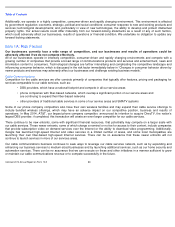Comcast 2014 Annual Report Download - page 37
Download and view the complete annual report
Please find page 37 of the 2014 Comcast annual report below. You can navigate through the pages in the report by either clicking on the pages listed below, or by using the keyword search tool below to find specific information within the annual report.-
 1
1 -
 2
2 -
 3
3 -
 4
4 -
 5
5 -
 6
6 -
 7
7 -
 8
8 -
 9
9 -
 10
10 -
 11
11 -
 12
12 -
 13
13 -
 14
14 -
 15
15 -
 16
16 -
 17
17 -
 18
18 -
 19
19 -
 20
20 -
 21
21 -
 22
22 -
 23
23 -
 24
24 -
 25
25 -
 26
26 -
 27
27 -
 28
28 -
 29
29 -
 30
30 -
 31
31 -
 32
32 -
 33
33 -
 34
34 -
 35
35 -
 36
36 -
 37
37 -
 38
38 -
 39
39 -
 40
40 -
 41
41 -
 42
42 -
 43
43 -
 44
44 -
 45
45 -
 46
46 -
 47
47 -
 48
48 -
 49
49 -
 50
50 -
 51
51 -
 52
52 -
 53
53 -
 54
54 -
 55
55 -
 56
56 -
 57
57 -
 58
58 -
 59
59 -
 60
60 -
 61
61 -
 62
62 -
 63
63 -
 64
64 -
 65
65 -
 66
66 -
 67
67 -
 68
68 -
 69
69 -
 70
70 -
 71
71 -
 72
72 -
 73
73 -
 74
74 -
 75
75 -
 76
76 -
 77
77 -
 78
78 -
 79
79 -
 80
80 -
 81
81 -
 82
82 -
 83
83 -
 84
84 -
 85
85 -
 86
86 -
 87
87 -
 88
88 -
 89
89 -
 90
90 -
 91
91 -
 92
92 -
 93
93 -
 94
94 -
 95
95 -
 96
96 -
 97
97 -
 98
98 -
 99
99 -
 100
100 -
 101
101 -
 102
102 -
 103
103 -
 104
104 -
 105
105 -
 106
106 -
 107
107 -
 108
108 -
 109
109 -
 110
110 -
 111
111 -
 112
112 -
 113
113 -
 114
114 -
 115
115 -
 116
116 -
 117
117 -
 118
118 -
 119
119 -
 120
120 -
 121
121 -
 122
122 -
 123
123 -
 124
124 -
 125
125 -
 126
126 -
 127
127 -
 128
128 -
 129
129 -
 130
130 -
 131
131 -
 132
132 -
 133
133 -
 134
134 -
 135
135 -
 136
136 -
 137
137 -
 138
138 -
 139
139 -
 140
140 -
 141
141 -
 142
142 -
 143
143 -
 144
144 -
 145
145 -
 146
146 -
 147
147 -
 148
148 -
 149
149 -
 150
150 -
 151
151 -
 152
152 -
 153
153 -
 154
154 -
 155
155 -
 156
156 -
 157
157 -
 158
158 -
 159
159 -
 160
160 -
 161
161 -
 162
162 -
 163
163 -
 164
164 -
 165
165 -
 166
166 -
 167
167 -
 168
168 -
 169
169 -
 170
170 -
 171
171 -
 172
172 -
 173
173 -
 174
174 -
 175
175 -
 176
176 -
 177
177 -
 178
178 -
 179
179 -
 180
180 -
 181
181 -
 182
182 -
 183
183 -
 184
184 -
 185
185 -
 186
186 -
 187
187 -
 188
188 -
 189
189 -
 190
190 -
 191
191 -
 192
192 -
 193
193 -
 194
194 -
 195
195 -
 196
196 -
 197
197 -
 198
198 -
 199
199 -
 200
200 -
 201
201 -
 202
202 -
 203
203 -
 204
204 -
 205
205 -
 206
206 -
 207
207 -
 208
208 -
 209
209 -
 210
210 -
 211
211 -
 212
212 -
 213
213 -
 214
214 -
 215
215 -
 216
216 -
 217
217 -
 218
218 -
 219
219 -
 220
220 -
 221
221 -
 222
222 -
 223
223 -
 224
224 -
 225
225 -
 226
226 -
 227
227 -
 228
228 -
 229
229 -
 230
230 -
 231
231 -
 232
232 -
 233
233 -
 234
234 -
 235
235 -
 236
236 -
 237
237 -
 238
238 -
 239
239 -
 240
240 -
 241
241 -
 242
242 -
 243
243 -
 244
244 -
 245
245 -
 246
246 -
 247
247 -
 248
248 -
 249
249 -
 250
250 -
 251
251 -
 252
252 -
 253
253 -
 254
254 -
 255
255 -
 256
256 -
 257
257 -
 258
258 -
 259
259 -
 260
260 -
 261
261 -
 262
262 -
 263
263 -
 264
264 -
 265
265 -
 266
266 -
 267
267 -
 268
268 -
 269
269 -
 270
270 -
 271
271 -
 272
272 -
 273
273 -
 274
274 -
 275
275 -
 276
276 -
 277
277 -
 278
278 -
 279
279 -
 280
280 -
 281
281 -
 282
282 -
 283
283 -
 284
284 -
 285
285 -
 286
286 -
 287
287 -
 288
288 -
 289
289 -
 290
290 -
 291
291 -
 292
292 -
 293
293 -
 294
294 -
 295
295 -
 296
296 -
 297
297 -
 298
298 -
 299
299 -
 300
300 -
 301
301 -
 302
302 -
 303
303 -
 304
304 -
 305
305 -
 306
306 -
 307
307 -
 308
308 -
 309
309 -
 310
310 -
 311
311 -
 312
312 -
 313
313 -
 314
314 -
 315
315 -
 316
316 -
 317
317 -
 318
318 -
 319
319 -
 320
320 -
 321
321 -
 322
322 -
 323
323 -
 324
324 -
 325
325 -
 326
326 -
 327
327 -
 328
328 -
 329
329 -
 330
330 -
 331
331 -
 332
332 -
 333
333 -
 334
334 -
 335
335 -
 336
336 -
 337
337 -
 338
338 -
 339
339 -
 340
340 -
 341
341 -
 342
342 -
 343
343 -
 344
344 -
 345
345 -
 346
346 -
 347
347 -
 348
348 -
 349
349 -
 350
350 -
 351
351 -
 352
352 -
 353
353 -
 354
354 -
 355
355 -
 356
356 -
 357
357 -
 358
358 -
 359
359 -
 360
360 -
 361
361 -
 362
362 -
 363
363 -
 364
364 -
 365
365 -
 366
366 -
 367
367 -
 368
368 -
 369
369 -
 370
370 -
 371
371 -
 372
372 -
 373
373 -
 374
374 -
 375
375 -
 376
376 -
 377
377 -
 378
378 -
 379
379 -
 380
380 -
 381
381 -
 382
382 -
 383
383 -
 384
384 -
 385
385 -
 386
386
 |
 |

Table of Contents
Newer services in wireless Internet technology, such as 4G wireless broadband services and Wi-
Fi networks, and devices such as
wireless data cards, tablets and smartphones, and mobile wireless routers that connect to such devices, may compete with our
high-speed Internet services. Our voice services continue to face increased competition from wireless and Internet-
based phone
services as more consumers choose to replace their traditional wireline phone service with these phone services.
Newer products and services are also driving changes in consumer behavior as consumers seek more control over when, where
and how they consume content and access communications services. For example, the increased availability of DVRs, video on
demand services and cable, broadcast and other video programming on the Internet including high-
quality original video
programming that may be viewed only through subscription video on demand services, as well as increased access to media
through wireless devices, have the potential to reduce the viewing of content through traditional linear television distribution outlets.
Some content providers are also beginning to offer programming directly to consumers over the Internet for a nominal fee. Reduced
viewing of content through traditional distribution outlets could adversely affect demand for our cable communications’
video
services, the price and amount of advertising that advertisers are willing to purchase from us, the amount multichannel video
providers are willing to pay to NBCUniversal for content, and the levels of DVD and theatrical sales. These newer products and
services have contributed to an increased number of entertainment choices available to consumers, which have caused and may
continue to cause audience ratings pressure for our content and intensify the challenges posed by audience fragmentation.
The success of any of these ongoing and future developments or our failure to effectively anticipate or adapt to emerging
competitors or changes in consumer behavior, including among younger consumers, could have an adverse effect on our
competitive position, business and results of operations.
A decline in advertisers’ expenditures or changes in advertising markets could negatively impact our businesses.
Our cable communications, cable networks and broadcast television businesses compete for the sale of advertising time with other
television networks and stations, as well as with all other advertising platforms, such as radio, print and, increasingly, online media.
We derive substantial revenue from the sale of advertising, and a decline in expenditures by advertisers, including through
traditional linear television distribution models, could negatively impact our results of operations. Declines can be caused by the
economic prospects of specific advertisers or industries, by increased competition for the leisure time of audiences and audience
fragmentation, by the growing use of new technologies, or by the economy in general. In addition, advertisers’
willingness to
purchase advertising from us may be adversely affected by lower audience ratings, which some of our cable networks have
experienced and may continue to experience. Advertising sales and rates also are dependent on audience measurement
methodologies and could be negatively affected if methodologies do not accurately reflect actual viewership levels. For example,
newer methods of viewing content (such as delayed viewing on DVRs or viewing content online) might not be counted in audience
measurements or may generate less, if any, revenue than traditional distribution methods, which could have an adverse effect on
our advertising revenue. Reductions in advertisers’ expenditures could adversely affect our revenue and businesses.
Our businesses depend on keeping pace with technological developments.
Our success is, to a large extent, dependent on our ability to acquire, develop, adopt and leverage new and existing technologies,
and our competitors’
use of certain types of technology and equipment may provide them with a competitive advantage. For
example, some companies and municipalities are building advanced fiber-
based networks that provide very fast Internet access
speeds, and wireless Internet technologies continue to evolve rapidly to allow for greater speed and reliability. We expect other
advances in communications technology to occur in the future. If we choose technology or equipment that is not as effective or
attractive
Comcast 2014 Annual Report on Form 10
-
K
32
